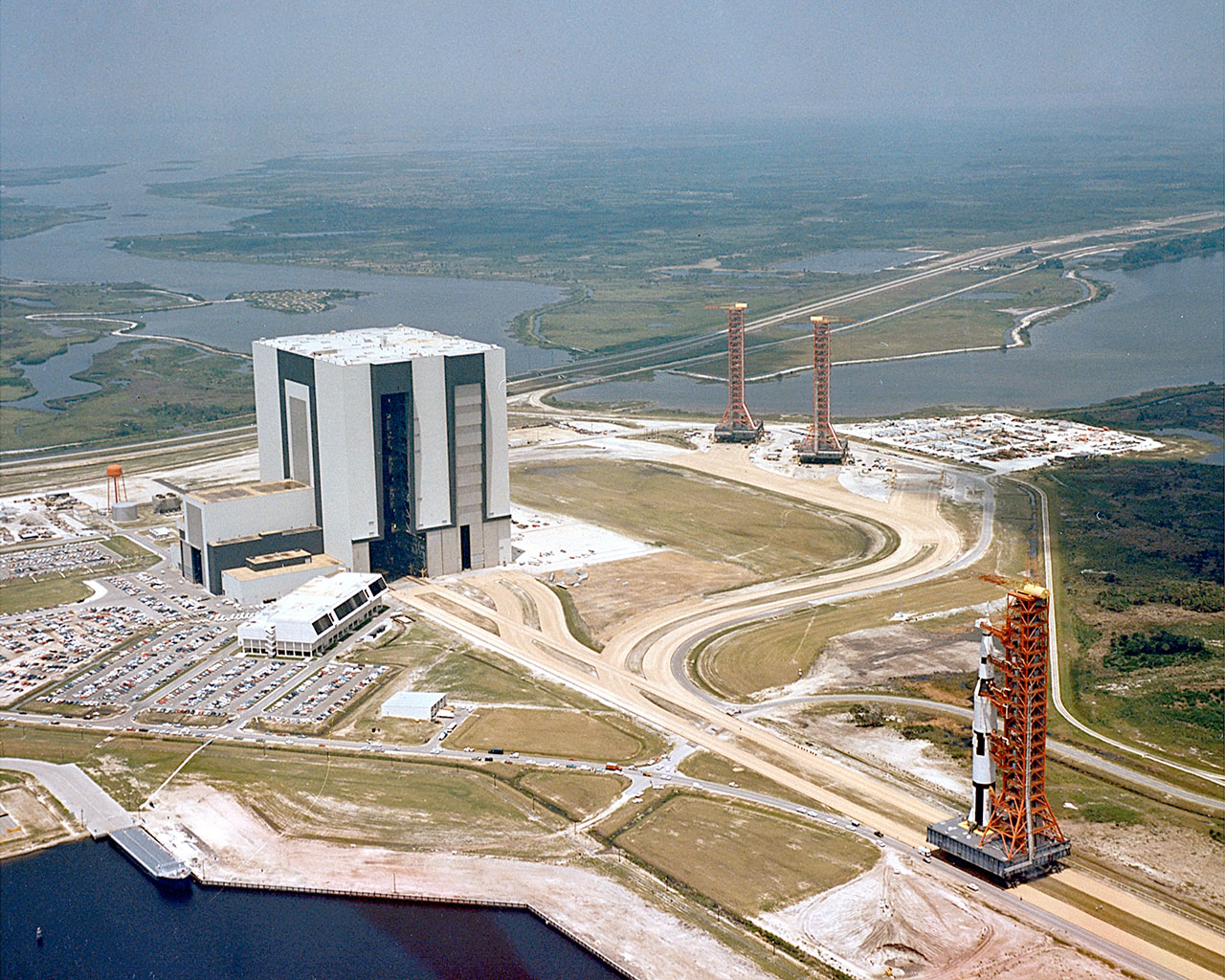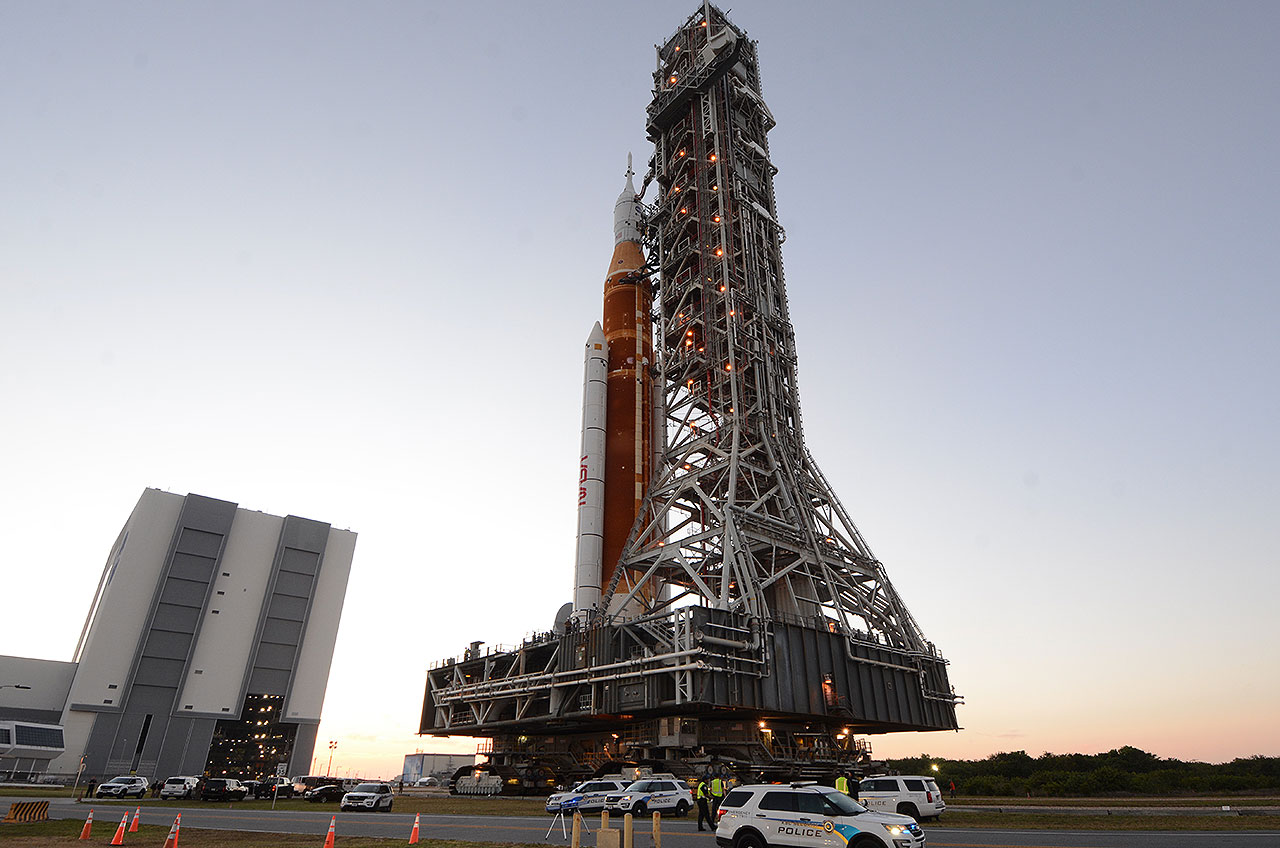“It was a sight unseen before by mankind.”
That was how NASA described the first rollout of a Saturn V rocket 56 years ago. Were it still in print today, the space agency’s “Spaceport News” might use that lede again — this time for the first Space Launch System (SLS) booster following in the tracks of its Apollo predecessor.
On Thursday evening (March 17), the Artemis 1 SLS emerged from the same Vehicle Assembly Building (VAB) at NASA’s Kennedy Space Center in Florida that the first Saturn V exited on May 25, 1966. Standing close in size and riding atop crawler transporters built for the Apollo program, both the SLS and earlier Saturn V each represented a new effort to send humans to the moon, though neither of the inaugural vehicles were built to achieve that goal.
The first Saturn V, designated 500-F, was a mockup assembled to test ground facilities. Its first stage had only one mock engine out of the five that would power the later moon-bound rockets. The vehicle was able to be loaded with propellants, however, and that fueling was demonstrated as 500-F stood on Pad 39A.
Similarly, the Artemis 1 SLS was making the overnight journey to Pad 39B for a “wet” dress rehearsal, including being fueled and put through a full countdown (minus the liftoff). Unlike 500-F, though, the first SLS will not be retired afterward. It will return to the VAB to be studied and serviced so it can launch the Artemis 1 mission, sending an uncrewed Orion spacecraft on a three-week trip around the moon and back.
Live updates: NASA’s Artemis 1 moon mission in action
“Every generation has its moment. This is going to be an incredible moment for this generation,” Tom Whitmeyer, NASA’s associate administrator for exploration systems development, said in a call with reporters. “In this business, you get used to a certain size and scale. I think we were pretty well tuned to that during the shuttle program. But every time I see this vehicle, it just catches your breath.”
Completed early Friday morning (March 18), the first SLS rollout came 11 years, 5 months and 6 days since President Barack Obama signed the NASA Authorization Act of 2010, which directed the agency to build the heavy-lift rocket. By comparison, the first Saturn V was rolled out five years to the day after President John F. Kennedy challenged the nation to “commit itself to achieving the goal, before this decade is out, of landing a man on the moon and returning him safely to Earth.”
Here is a look at how the first rollouts of the Apollo Saturn V and Artemis Space Launch System (SLS) rockets further compared.
| Apollo Saturn V | Artemis Space Launch System (SLS) | |
|---|---|---|
| Vehicle / Mission | 500-F / facility verification | Block 1 / Artemis I |
| Rollout date | May 25, 1966 | March 17-18, 2022 |
| Departure | Vehicle Assembly Building (VAB), High Bay 1 | Vehicle Assembly Building (VAB), High Bay 3 |
| Destination | Pad 39A | Pad 39B |
| Mobile Launcher | ML-1 (later MLP-3) | Artemis ML-1 |
| Crawler-Transporter | No. 1 | No. 2 |
| Weight atop crawler (including ML) | 12.3 million pounds (5.6 million kilograms) | 14.8 million pounds (6.7 million kilograms) |
| Vehicle height | 363 feet (111 meters) (ML: 445 ft or 136 m) | 322.4 feet (98.3 meters) (ML: 370 ft or 113 m) |
| Distance traveled | 3.5 miles (5.6 km) | 4.2 miles (6.8 km) |
| Maximum speed | 1 mile per hour (1.6 kilometers per hour) | 0.8 miles per hour (1.3 kilometers per hour) |
| First motion | 10 a.m. EDT (1400 GMT) | 5:47 p.m. EDT (2147 GMT) |
| Arrival at pad | ~7 p.m. EDT (2300 GMT) | ~1:30 a.m. EDT (0530 GMT) |
| Hard down on pad | ~9 p.m. EDT (0100 GMT) | ~4:15 a.m. EDT (0830 GMT) |
| Total time in motion | ~9 hours | ~11 hours |
| Wet dress rehearsal | Oct. 12, 1966 (complete automatic liquid oxygen and liquid hydrogen [LOX and LH2] loading) | April 3, 2022 (scheduled); loading propellant tanks and practice launch countdown |

| Apollo Saturn V | Artemis Space Launch System (SLS) | |
|---|---|---|
| Mobile Launcher rolled into VAB | Jan. 28, 1966 | Dec. 20, 2019 |
| First element stacked on ML | March 15, 1966: SI-C-F | Nov. 21, 2020: first of 10 segments for solid rocket boosters |
| Vehicle assembly | First stage: SI-C-F; Second stage: S-II-F; Third stage: S-IVB-F; Instrument Unit: S-IU-500F; Spacecraft Lunar Module Adapter mockup; M-11 Command and Service Module model; Launch Escape System | Twin five-segment solid rocket boosters; Core stage; Launch Vehicle Stage Adapter (LVSA); Orion Stage Adapter (OSA); European Service Module; Orion spacecraft; Launch Abort System |
| Stacking complete | May 2, 1966 | Oct. 21, 2021 |
| Total days to stack | 48 | 335 |

See more photos from the Saturn V and Space Launch System first rollouts at collectSPACE.com.
Follow collectSPACE.com on Facebook and on Twitter at @collectSPACE. Copyright 2022 collectSPACE.com. All rights reserved.

